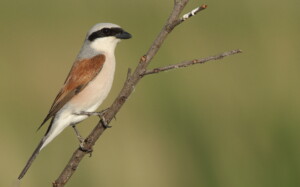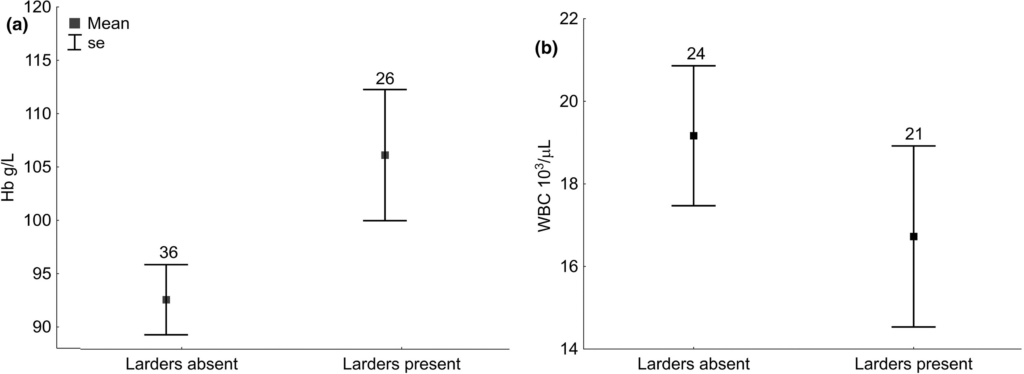
LINKED PAPER
Storing prey in larders affects nestling haematological condition in the Red-backed Shrike (Lanius collurio). Golawski, A., & Kondera, E. 2023. IBIS. DOI: 10.1111/ibi.13104. VIEW
Shrikes are known for impaling their prey onto plant spines or barbed wires. The function of these prey larders remains a matter of debate. The larders might provide a food source for difficult times (Golawski et al. 2020), or they might signal the territory quality of the local male (Antczak et al. 2005). Some shrike species, such as the Red-backed Shrike (Lanius collurio), mainly store prey during the nestling phase, suggesting that their larders are used to feed the young birds. If this explanation is valid, you would expect to find nestlings in better condition in territories with larders compared to territories without this back-up food source. In a recent IBIS-study, Artur Golawski and Elzbieta Kondera put this hypothesis to the test.
Blood parameters
The researchers monitored twenty nests of Red-backed Shrikes around the town of Siedlce in east-central Poland. Nine nests were associated with larders, whereas eleven nests were not. The condition of the nestlings was assessed through several blood parameters. High numbers of red blood cells and high concentrations of haemoglobin indicate good body condition, while high numbers of white blood cells point to stress or infection (Minias et al. 2015). Analyses of these blood parameters showed that “the nestlings of food-storing Red-backed Shrikes had higher haemoglobin concentrations and lower WBC [i.e. white blood cell] counts.” In other words, nests associated with larders contained nestlings in better condition.

Figure 1. Nestlings associated with larders were in better condition, indicated by higher haemoglobin concentrations (figure a) and lower white blood cell counts (figure b).
Other functions
These findings support the idea that Red-backed Shrikes use larders as a back-up food source during the breeding season. By storing prey on spines, the parents ensure a stable supply of food for their nestlings. However, this does not mean that nestling provisioning is the only function of these larders (Yosef & Pinshow 2005). They might still function as quality indicators or back-up food sources during harsh conditions. Indeed, adult birds might occasionally pass by the larder for a midnight snack.
References
Antczak, M., Hromada, M. & Tryjanowski, P. (2005). Spatio-temporal changes in great Grey shrike Lanius excubitor impaling behaviour: From food catching to communication signs. Ardea 93: 101–107. VIEW
Golawski, A., Mroz, E. & Golawska, S. (2020). The function of food storing in shrikes: The importance of larders for the condition of females and during inclement weather. European Zoological Journal 87: 282–293. VIEW
Minias, P. (2015). The use of haemoglobin concentrations to assess physiological condition in birds: A review. Conservation Physiology 3: cov007. VIEW
Yosef, R. & Pinshow, B. (2005). Impaling in true shrikes (Laniidae): A behavioral and ontogenic perspective. Behavioural Processes 69: 363–367. VIEW
Image credits
Top right: Red-backed Shrike (Lanius collurio) | Antonios Tsaknakis | CC BY-SA 4.0 Wikimedia Commons
Blog posts express the views of the individual author(s) and not those of the BOU.
If you want to write about your research in #theBOUblog, then please see here




